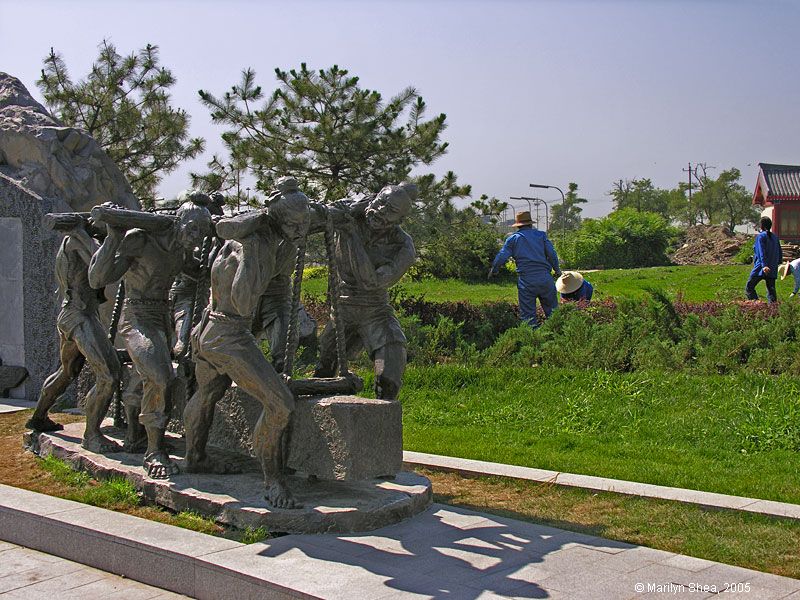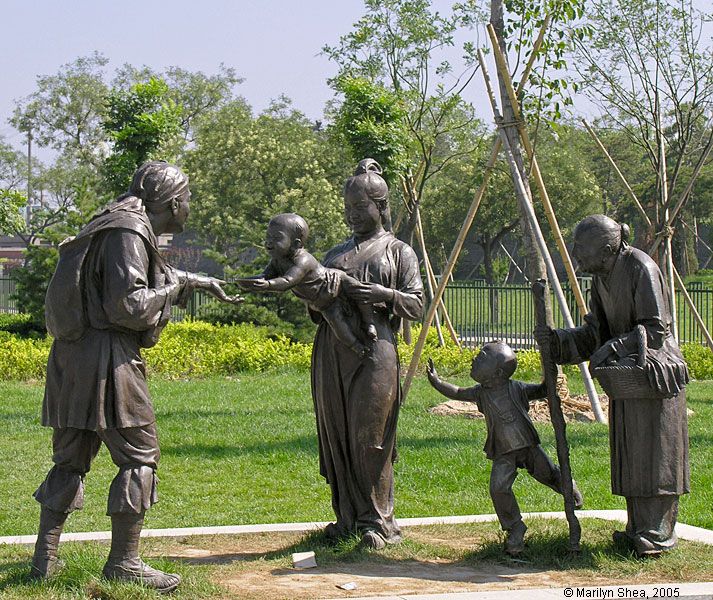 |
| The Jin Dynasty, 金朝 (Jīn Cháo) 1115–1234, was established when a Manchurian people, the Jurchens, moved to expand their territories both toward the south and the west. In 1125, they moved against the Liao in the west and pushed them out of Manchuria, Mongolia, and the northern sections of China.
Building on that success, they moved south to attack the Song Dynasty in 1127. They attacked and defeated Kaifeng, the capital of the Northern Song Dynasty. Of course, we call it the Northern Song today to differentiate it from the much smaller Southern Song Dynasty that remained after the Jurchen took over most of the territory north of the Yangtze River. By 1141, the fighting had ceased and the Jin Dynasty was in firm control of the greater north section of China, including Kaifeng and Beijing. The Southern Song Dynasty controlled areas south of the Huai River and made their capital in Hangzhou. What is now Xinjiang, Tibet, Kunming, and parts of Gansu were not included. They were ruled by other peoples. Map drawn by Yu Ninjie (2004). The Jurchen followed the lead of the Khitan and established a modified form of Chinese governance while maintaining their tribal identities and Khanates. In this they were the precursors of the later Manchurian people, the Manchus, who established the Qing Dynasty. Unlike the Khitan, who had two distinct systems, the Jurchens had a unified and more centralized system of governance with different flavors for different regions. At first the Jin capital was in Manchuria, in a city called Huining, but in 1153 it was moved to Yanjing (Beijing) by Emperor Wanyan Liang 完顏亮 (Wányán Liàng, 1122 - 1161) so he could get away from rival factions in Manchuria. He also wanted to have a better base from which to attack the Song Dynasty. He made the city his central capital, Zhongdu. He embarked upon a program of Sinification of government and institutions, attempting to switch his power base from the Jurchen to the Chinese and prepare to conquer all of China. He had a lot of people killed to stabilize his rule. It didn't work. He was assassinated. Not only that, but, after his death, the Jurchens demoted him from Emperor to a mere prince. But the capital remained in Zhongdu (Beijing). His successor Emperor Shizong 世宗 (Shìzōng, 1123 - 1189) set about repairing the country, making peace with the Song, and building the new capital. It was under his reign that Lugou Qiao, the Marco Polo Bridge, was begun. The work lasted from 1188 to 1192 and was finished during the reign of Emperor Zhangzong 章宗 (Zhāngzōng, 1168 - 1208). Before the new stone bridge was built, pontoon bridges would be set up to cross the river. Each spring, after the river settled, a site would be chosen depending on the height of the river and the condition of the banks. As the river was central to trade, the situation was not ideal. As trade increased, the city grew, and wealth was available, a more permanent solution was both necessary and possible. Both Emperor Shizong and Emperor Zhangzong saw Sinification as a threat to the Jurchen rule and strength. Jurchens were required to wear traditional Jurchen clothes and everyone wore their hair in Jurchen style. Notice that even the workmen wore their hair pulled up in a knot at the back of their heads and covered with a cloth. The cloth could also be a cap or hat. Shizong established schools to teach the Jurchen language and had many Chinese, Buddhist, and Daoist works translated into Jurchen. It wasn't easy to maintain the warrior skills that had developed in the harsh realities of Manchuria. As the ruling class, the Jurchen had access to plentiful harvests without lifting a bow and arrow. It was much easier to just go to the market for food and use leisure time to drink and gamble. The various emperors had to struggle to maintain discipline when survival no longer required it. Many of their efforts backfired. As the Jurchen lived and worked in the south they absorbed the habits of the city dweller. When they read the Chinese classics in Jurchen, they learned Chinese and Confucian ideas. Both Buddhism and Daoism had already spread to Manchuria, but now they were exposed to a Chinese version of each. Emperor Shizong was interested in an ascetic form of Daoism that had been developed by Wang Chongyang 王重阳 (Wáng Chóngyáng) called Quanzhen, or Complete Perfection Daoism. He invited followers of Wang Chongyang to his palace to discuss the principles and philosophy with him. After Emperor Shizong died, his successor Emperor Zhangzong suppressed Quanzhen Daoism and the followers and monks dispersed. (More about this in the history of the White Cloud (Baiyuan) Temple found on the index of this page.) The construction of the Marco Polo Bridge was only one of the projects undertaken to improve and expand Yanjing (Beijing). The Jurchens were great builders and expanded and improved cities all over their territory. The center of their city was southwest of Tian'anmen Square, closer to the site of the Lugou Qiao. They built an enormous palace complex to house the emperor and government. They built an artificial lake within the palace grounds and gardens to surround it. Little remains of the Jurchen Beijing. The battles fought by the Mongols and then the Chinese burnt much of the city. Additional sections were razed when the city became the capital of the Yuan Dynasty, and then again when it became the capital of the Ming Dynasty. The Lugou Qiao remained, in part, because it was built so well, and in part, because it was admired. As soon as it was built it became one of the things to see when visiting Yanjing. Tourist guides memorize the list of eight places to this day. 燕京八景 Eight Scenic Spots of Yanjing
Below, one of the new sculptures added in 2005 to the Lugou Qiao park illustrates life during the Jurchen Jin Dynasty. The poles seen are supports for new sapplings, not an illustration of tee-pee housing. |
 |
http://hua.umf.maine.edu/China/beijing2.html
Last
update: October 2009
© Marilyn Shea, 2009